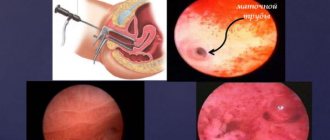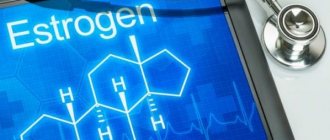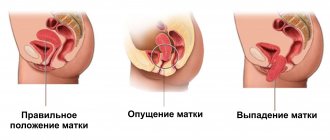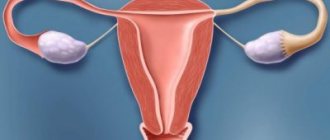Author: Rebenok.online · Published 02/02/2017 · Updated 02/14/2019
Each newborn girl’s body contains about
1–1.5 million follicles —possible future eggs.
Most of them die off by the time the first menstruation appears, and some die off during the woman’s life. Only a small number of them participate in ovulation and have the ability to fertilize. They can die not only for natural reasons, but also under the influence of many negative factors. This nuance is one of the reasons for the development of female infertility. How and how many days does a woman’s egg mature? Interesting facts that every expectant mother should know.
Maturation of a woman's egg
The process of egg maturation (OC) from a biological point of view is very complex. They are formed in the girl’s body when she is still in the womb , i.e. long before her birth. Before puberty, they are at rest, and a certain part of them stops their development and dies. When your first period occurs, single eggs begin to mature and prepare for potential fertilization.
The process of egg maturation in a woman by day:
- before puberty, NCs are at rest (some of them die off for natural reasons or under the influence of certain factors);
How do they ripen?
As menstruation approaches, the ovary begins to mature the egg. In this case, usually only one follicle increases in size. This feature is intended by nature so that in the future the woman will develop a singleton pregnancy. However, there are exceptions to every rule.
It also happens that in one month not one, but several eggs mature. If for some reason a woman has two eggs mature at the same time, this significantly increases the likelihood of conceiving twins.
The egg is located in the ovary in a special anatomical formation called a follicle. Under the influence of specific hormones, several follicles begin to grow simultaneously, but then only one of them increases. Experts call it dominant. In the future, it is in it that the egg will actively mature for this menstrual cycle.
Every day the dominant follicle grows in size. Every day before ovulation it increases by 2 mm. When it reaches a size of 1.8-2 cm, it usually bursts and an egg is released. At this time, she has already reached sufficient maturity for conception to be possible.
In order for fertilization to be possible, the egg goes through a complex path, moving from the ovary to the fallopian tube. In it she can meet sperm. Usually the egg remains viable for 24 hours.
Many women mistakenly believe that only one sperm is required to conceive. This is not entirely true. In order for fertilization to occur, a sufficiently large number of active and viable sperm are required. They are necessary so that only one “lucky” person penetrates the egg and conception occurs.
If fertilization does not occur, then the egg inevitably dies. In its place, a special formation is formed in the ovaries - the corpus luteum. Before its appearance, a blood clot forms at the site of the burst follicle, but under the influence of progesterone (the female sex hormone) it resolves and is replaced by the corpus luteum.
If pregnancy does not occur, then the corpus luteum also regresses. This also helps to reduce the level of progesterone in the blood. At the same time, the concentration of estrogens, female sex hormones, begins to increase. Changes in hormonal levels contribute to the beginning of a new period of egg maturation for the next menstrual cycle.
The process of egg maturation in women of reproductive age is continuous. As soon as one egg has matured and been released, the process of maturation of a new one begins almost immediately. It is important to note that even a healthy woman can experience several anovulatory cycles throughout her life. This means that in some menstrual cycle a follicle is formed, but there is no egg in it. This situation is also called “empty follicle syndrome.” Usually it develops no more than once a year.
When does the egg mature after menstruation?
If the menstrual cycle is 28–30 days, then in most cases the egg begins to mature on days 14–16 of the cycle, but this indicator depends on the individual characteristics of the body; ovulation can be late or early (the egg can mature immediately after menstruation).
For a woman planning a pregnancy, it is necessary to know exactly what day the egg matures. Because only during this period can conception occur . Methods for determining the day of egg maturation:
- if you measure your basal temperature day for several months and record the data, you can determine the day of ovulation by the increase in indicators (this technique may give inaccurate results; some diseases of the reproductive organs or infections of the reproductive system can change the basal temperature, and the symptoms do not cause discomfort);
How many eggs mature in one cycle (per month)?
In most cases, during one ovulation, a woman matures one egg , but there are exceptions.
two ovulatory processes can occur in a woman’s body over a short period of time. There are cases when two follicles mature in one cycle.
This is not a deviation from the norm. In a woman, when several NCs mature, the chances of multiple pregnancy increase.
Nuances that are important for women to know:
- if during one cycle one nuclear center matures, then one child will be conceived;
What are ovaries?
These are the most important organs of any woman.
They allow girls to realize their main natural function - to give birth to children. They are located in the small pelvis in the amount of two pieces. In the case of congenital pathologies or acquired injuries, there may be none at all, or there may be only one. Three ovaries in a female body are nonsense; no more than a couple of dozen such anomalies are known throughout history, and the “functionality” of the organs was close to zero.
The same applies to size - healthy glands do not exceed 8 cubic centimeters in volume. Smaller size does not always take away functionality, but gigantism renders organs useless.
Since childhood, the ovaries contain eggs that mature over time. Initially, there are about a million of them, but not all survive to the point of puberty - diseases, especially infectious ones, take their toll. By the beginning of reproductive age, the glands begin to produce specific female hormones.
- Estrogen. Makes a woman a woman, allowing her to conceive and give birth to a child.
- Progesterone. A typically female hormone that ensures the normal course of pregnancy and also promotes the onset of lactation.
- Androgens. These are male hormones, but in the female body they help maintain the functionality of the reproductive glands.
As soon as the ovaries “run out” of eggs, menopause (menopause) begins. A woman's periods stop and she loses her ability to bear children.
Important! A healthy girl has about half a million eggs stored by the time she reaches puberty. Over the course of life, their number will only decrease. If a woman abuses alcohol or tobacco products, then the ability to bear children can occur long before the time of natural menopause.
Maturation of a woman's egg
The maturation of the female reproductive cell is a complex multi-stage process. Eggs are present in large numbers in the ovaries of a newborn girl. But until the arrival of the first menstruation - menarche - they will be in a dormant state.
The process of egg maturation is controlled by hormones. It goes through several stages:
- Follicle development phase. The female cell is initially located inside a special vesicle called a follicle. Under the influence of a specific hormone, several follicles enlarge at once. But only one of them will actively grow, sometimes two. It's called dominant. Every day its volume increases by 2 mm.
- Ovulation. After the follicle enlarges - its average size at the time of ovulation is 1.8–2 cm - its membrane ruptures. A mature egg, ready for fertilization, comes out and begins its “journey” through the fallopian tubes.
If fertilization does not occur during this time, then it will die and come out during the next menstruation.
After 40 years, the number of eggs in women declines rapidly.
Egg storage: what you need to know about the ovaries and their health?
What exactly do they do?
The most famous function is that they contain eggs that contain half of the DNA (the second is in the sperm, when they join, an embryo is formed).
Normally, about 10-15 pieces “keep up” every month, and only one or two grow enough to leave the ovaries and move along the fallopian tubes to the uterus, where they may (or may not) meet sperm. In addition to being a “house” for eggs, the ovaries are also a “factory” for hormones. They create estrogen and progesterone, important for reproductive health, as well as testosterone. Hormones leave the ovaries and spread throughout the body through the circulatory system. They also improve bone health, muscle health, and even help brain function.
How many eggs are there in the body?
A girl is born with a full set of eggs - on average 1-2 million, but they mature gradually. By adolescence, 300 thousand remain, by menopause - zero. Most cells die on their own, and the body absorbs them without attracting your attention. About 400 go through the ovulation process. Ovulation usually occurs every month. If fertilization does not occur, hormone production stops and menstruation begins.
What does pain in this area mean?
1. Cyst
The follicle can become inflamed and develop into an ovarian cyst. Most of these cysts are small and harmless, and women are not even aware of them. Such cysts go away on their own, but can sometimes cause pain and affect menstrual periods.
2. Polycystic disease
Acne, weight gain, menstruation problems, increased hair growth are just some of the symptoms associated with polycystic disease and overproduction of male sex hormones. In many cases, to pacify the body, it is enough to take hormonal drugs.
3. Ovarian cancer
More than 20 thousand women a year receive such a diagnosis from doctors. This type of cancer is often called the silent killer because the tumor often has time to develop greatly. Symptoms include nausea, pain in the lower abdomen or back, diarrhea or constipation, frequent urination, a feeling of constant fullness in the abdomen, and loss of energy. If these symptoms occur more than three times a week, contact your doctor.
What happens to the ovaries during menopause?
At this time, the ovaries gradually reduce their speed and “calm down.” It happens that there are no more eggs, but the level of hormones remains high, and this leads to an irregular cycle, mood swings, problems with sleep and hot flushes in different parts of the body.
How to maintain health in this area?
It is advisable to do an ultrasound once a year in order to track health problems in time and solve them. It is advisable to quit smoking - chemical compounds in cigarettes contribute to the faster destruction of eggs. Maintain a normal weight for your height to avoid menstrual problems and reduce your risk of developing polycystic disease.
Popular
- Give birth and it will pass: how and why women are refused treatment
Did you like the article? Subscribe to the news and stay up to date with the most interesting and useful news.
Thank you.
We have sent a confirmation email to your email.
Symptoms of the onset of ovulation
There are potential and subjective signs of ovulation. The first group includes:
- Change in the nature of vaginal mucus. The volume of discharge increases and its consistency changes. They become thicker and more viscous.
- Feeling of discomfort in the lower abdomen. Sometimes there is even pain.
- Slight increase in the size of the mammary glands. The breasts also become more sensitive and may ache a little.
- Increased sexual desire.
- Deterioration in general health.
The described conditions can occur not only on the days of ovulation, but also appear before and after its completion.
There are also objective signs of ovulation. This:
- Increase in basal temperature. After menstruation it remains at 36.5–36.7 °C. After the egg leaves the follicle, it rises to 37.0–37.5 °C.
- Slight dilation and softening of the cervix. Determined during examination in a gynecological chair.
- Increased volume of luteinizing hormone. Determined in the laboratory.
Features of egg development
Eggs are female reproductive cells. They are unique in their structure, because... contain exactly half the set of chromosomes. When merging with male cells, the unborn child is conceived.
Each woman has an individual number of these cells and is measured in the thousands. After reaching 12–13 years of age (puberty), a portion of these cells mature monthly. The period of their maturation is called the menstrual cycle, it is counted from the first day of menstruation until the beginning of the next menstruation. The normal period can vary from 25 to 35 days.
Period of maturation of the female reproductive cell
The period of maturation of germ cells is called ovulation, it is at this time that the chance of conceiving a child is maximum. Ovulation is calculated individually, based on the cyclicity of menstruation.
Usually ovulation occurs in the middle of the cycle, i.e. 7-10 days after the end of menstruation. The timing may vary depending on the state of women's health. This is influenced by:
- the work of the thyroid gland and other organs that create hormonal levels;
- taking medications;
- nervous tension;
- improper lifestyle, nutrition;
- infections, genital diseases.
There are 3 stages of formation of mature eggs:
- Proliferative: begins after menstruation, i.e. on days 6-7 of the cycle. Follicles mature in the ovaries, from which eggs are subsequently released. This process is controlled by hormones.
- Ovulation: Under the influence of luteinizing hormone, eggs are released from the follicles. The ovaries produce estrogen, the body is ready to conceive.
- The secretory phase begins on the 15-16th day of the cycle and lasts until its end. After the release of the egg, space is freed up in the follicle, which will be occupied by the corpus luteum. This is the name of the gland that will produce progesterone. The hormone is necessary for the fertilized egg to attach to the wall of the uterus and for the pregnancy to develop normally.
On what day does ovulation occur after menstruation?
Not in all cases, egg maturation is carried out strictly in accordance with normal parameters. To understand how long after menstruation ovulation occurs, it is enough to familiarize yourself with the peculiarities of the functioning of the female reproductive organs. The enlargement of the follicles in which oocytes are formed is carried out under the influence of estrogens. If they are produced in the required quantity, the follicle grows by 1-2 mm per day. The release of the egg occurs a few days after the follicle becomes mature. By this time it should reach 18-25 mm. If estrogens are produced more actively than usual, the follicles mature earlier. The following factors contribute to this:
- Stressful situations;
- Hormonal disorders;
- Hereditary diseases;
- Metabolic disease;
- Infectious and inflammatory problems.
Stages of egg development
Spontaneous ovulation after menstruation is not uncommon. In gynecology it is considered a pathology. It provokes a change in the cyclicity of physiological processes and is an obstacle to the successful fertilization of the oocyte. The fertilized egg will not be able to penetrate the upper layers of the uterine cavity, as it will not have time to reach the required volume and structure.
How many gametes can mature in 1 cycle?
Most often, 1 egg matures between periods, but there are other options. A woman can ovulate 2 times in one cycle or two follicles can mature, and a gamete will be released from each.
Such processes are not considered pathology or deviation from the norm. However, they not only increase the chance of conceiving a child, but also the risk of multiple pregnancy.
There are situations when there is no ovulation at all and no follicle formation occurs. It is impossible to determine this condition on your own. The reasons for the lack of ovulation may be disturbances in the production of hormones, infections, genetic and other diseases.
Can an egg fail to mature?
Certainly. This happens regularly, 2-3 times a year for sure. This time is defined as a cycle without ovulation. Don't be afraid - this is the norm. The woman’s body itself allocates time for rest and regeneration of the ovaries. After 33 years, the absence of ovulation increases to 3-4 gases per year. But there are other reasons:
- early menopause;
- ovarian dysfunction;
- problems with ovulation (there is not enough time for the egg to fully mature or it is completely not viable);
- genetic abnormalities;
- diseases of the female reproductive system.
What affects the viability of female germ cells?
The viability of gametes determines how many days after ovulation they live and how quickly they can be fertilized. The more viable the cells, the higher the chance of conception. The quality of the eggs is influenced by the genetic material from which it is created and the woman’s health status. External factors do not play a role in this.
Bad habits, unhealthy lifestyle, unbalanced diet, chronic diseases are factors that have an indirect effect on the quality of gametes. They lead to mutation of genetic material, diseases, and deterioration in the quality of work of all body systems.
How can you tell when an egg has been released from the follicle?
Typically, ovulation is diagnosed when preparing for pregnancy. At home, you can find out that the egg has left the follicle in several ways:
- Use ovulation tests. They are sold in pharmacies, the principle of their work is the detection of luteinizing hormone of the pituitary gland. Before the release of the gamete, its amount in the blood is maximum.
- Charting your basal body temperature. This is not a very convenient method; it requires measuring the temperature in the rectum every morning. Before ovulation it decreases, and the next day it rises.
- Calendar calculations. If your menstrual cycle is regular, you can calculate the day of ovulation. The days before and after it are considered the most favorable for conception.
How to find out: has ovulation occurred?
At home, this can be determined by the following methods:
- Provided that your periods are regular - using the above-described calendar. But how can you find out if it happened?
- This can be determined by measuring basal temperature, which usually, when increased, indicates the release of an egg ready for fertilization. Temperature during ovulation can be determined using the appropriate graph. As a rule, it increases by half a degree.
- An ovulation test is also a convenient method. It is very similar to a pregnancy test, but it shows two lines not when fertilization has occurred, but when the egg leaves the ovary.
What happens to an unfertilized egg?
After leaving the follicle, the egg enters the fallopian tube. The unfertilized gamete is viable for another day, after which it dies and is resorbed. The short lifespan of an egg is explained by the fact that only half of the chromosomes are present in it, it cannot synthesize protein on its own and lives off the substance that was embedded in it.
If fertilization does not occur, the corpus luteum stops synthesizing progesterone. Without its support, the functional layer of the uterus peels off and menstruation occurs.
What is ovulation?
Remember about the eggs that mature in the ovaries for the time being?
So, with the first menstruation of a girl/girl, they begin to exit into the fallopian tubes. If at this time the egg meets the sperm, then conception occurs. This usually happens 14 days before your period (on average), but different women have different menstrual cycles, so this timing may vary. It takes about 4-6 minutes for an egg to leave the ovary, but ovulation itself lasts from 24 to 36 hours, it all depends on the individual anatomical characteristics of each woman.
If there is no meeting with the sperm or something interferes with fertilization, then the “unused” egg is excreted from the body with the first menstruation.
If pregnancy occurs, ovulation temporarily stops, and menstruation stops accordingly. This happens in 95% of cases, sometimes menstruation is observed after conception. Usually they occur in a special way and are distinguished by the abundance and smell of discharge.
Important! On average, ovulation occurs every 28-32 days. But sometimes the egg may be released twice a month. This is not a pathology, but it interferes with scheduling the menstrual cycle, which especially affects pregnancy planning.










